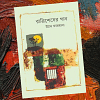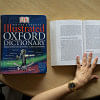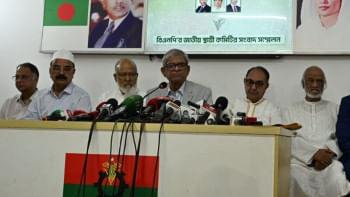Unique stall decor at the Ekushey Boi Mela

Every year, in February, Dhaka's Suhrawardy Uddyan is dotted with colourful pavilions and stalls inviting readers from across the nation. Publishers come up with unique and creative ideas to adorn their spaces, in an attempt to make themselves stand out in the crowd. While some of them depend on traditional motifs and logos, others use the pictures of prominent authors and new books that they are publishing.
This year, while strolling across the Ekushey Boi Mela, I came across a variety of styles in stall decor. Despite the delay in inauguration, publishers have put in a lot of effort in designing their spaces, bringing together a fascinating display for visitors. Many pointed out that it was disheartening that the fair would be ending so soon, but, the silver lining to it was the considerable turnout despite the short duration.
Anya Prakash's pavilion featuring Humayun Ahmed is almost impossible to miss. Located right next to the lake, the pavilion is modelled after a one-storey building, with a life size cutout of the eminent author looking over the rooftop. From a distance, it looks like Ahmed is actually present at the fair, smiling at his readers and cherishing the festive atmosphere of the Boi Mela.
Another stall that grabbed my attention was Kureghar's rural setup. Living up to its name, the publishing house presents an overall aesthetic charm, with an earthy colour scheme. The graphics of manuscripts add a touch of old world charm, and ropes wrapped around the pillars complement the theme.

Mizan Publishers, on the other hand, continues its legacy of recreating the Curzon Hall. Their pavilion imitates the British-era architectural marvel and serves as a source of attraction amidst the busy fair. Through their work, this publication house intends to promote Bangla heritage and culture.
Considering the main essence of Amar Ekushey Boi Mela and International Mother Language Day, Gourab Prokashoni has designed its stall centering the language movement. They used Bangla alphabets and characters to represent the very movement celebrated by the fair—with letters dangling from the roof of the stall and printed across the banner.
Shobdoshoili's stall, displaying achromatic colours, ribbons, and other decorations, explores the various elements of a book. The black and white colour palette symbolises the relationship between ink and paper. In an age where we are slowly drifting away from physical books and switching to digital media, Shobdoshoili wants to revive the practice of writing and producing quality content.
Bhashachitro, on the other hand, has used recycled materials to decorate their stall. Old manuscripts of published books and their colourful cover art create a unique collage on their walls. In order to captivate readers, the publishers came up with the idea of a selfie corner featuring the discarded book covers. It provides a space for readers to interact with authors, get their autographs, and take pictures with them.
Following the idea of in-house pavilions from Kolkata's Boi Mela, Shrabon Prokashoni decided to create an inclusive corner for readers of all age groups. Visitors can walk inside their cart, browse through new releases, and sit and talk with authors.
My personal favourite from the lot is Nabanna Prokashoni's culturally rich stall. From the bamboo walls to jute mats, it offers an ideal representation of Bengali culture featuring colourful earthenware pots, paper decorations, kula, chaluni, and other bamboo handicrafts. Everything from this stall reminded me of a typical village fair with simple ornamentations, much like the initial days of Boi Mela, when stalls were not as sophisticated and publishers did not have much resources to adorn their displays.
Maisha Islam Monamee likes reading, scribbling, and blogging. Suggest her new ideas and follow @monameereads on Instagram.

 For all latest news, follow The Daily Star's Google News channel.
For all latest news, follow The Daily Star's Google News channel. 








Comments